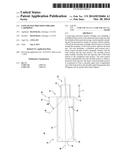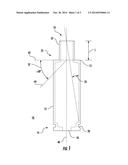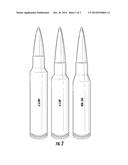Patent application title: LONG-RANGE PRECISION FIREARM CARTRIDGE
Inventors:
David Kerley (Saratoga, CA, US)
IPC8 Class: AF42B536FI
USPC Class:
102469
Class name: Cartridges case breech end structure
Publication date: 2014-10-30
Patent application number: 20140318404
Abstract:
A long-range precision firearm cartridge case including a cylindrical
body portion with a head end and an opposite end, the cylindrical body
portion having a central aperture extending into the head end for receipt
of a primer, and the cylindrical body portion having a cartridge
extraction groove formed around the periphery of the body portion
adjacent the head end. The case including a cylindrical neck portion and
a frusto-conical shoulder portion integrally formed with the body portion
and the neck portion. The shoulder portion tapers radially inwardly from
the opposite end of the body portion to the cylindrical neck portion. The
neck portion extends longitudinally from the shoulder portion to define a
projectile receiving end. The frusto-conical shoulder portion is
constructed to form a shoulder angle with a longitudinal axis of the body
portion, the shoulder angle being greater than 30 degrees and no greater
than ninety degrees.Claims:
1. A long-range precision firearm cartridge case comprising: a
cylindrical body portion with a head end and an opposite end, the
cylindrical body portion having a central aperture extending into the
head end for receipt of a primer, and the cylindrical body portion having
a cartridge extraction groove formed around the periphery of the body
portion adjacent the head end; a cylindrical neck portion; a
frusto-conical shoulder portion integrally formed with the body portion
and the neck portion, the shoulder portion tapering radially inwardly
from the opposite end of the body portion to the cylindrical neck
portion; the neck portion extending longitudinally from the shoulder
portion to define a projectile receiving end; and the frusto-conical
shoulder portion constructed to form a shoulder angle with a longitudinal
axis of the body portion, the shoulder angle being greater than 30
degrees and no greater than ninety degrees.
2. The long-range precision firearm cartridge case claimed in claim 1 wherein the neck portion has a length greater than the diameter of a bullet or projectile received in the projectile receiving end.
3. The long-range precision firearm cartridge case claimed in claim 1 wherein the body portion tapers radially inwardly from the head end to the opposite end, the amount of taper being less than 0.01 inches per inch of the body portion length.
4. A long-range precision firearm cartridge case as claimed in claim 1 including a firearm chamber reamer for use with the cartridge case.
5. A long-range precision firearm cartridge case comprising: a cylindrical body portion with a head end and an opposite end, the cylindrical body portion having a central aperture extending into the head end for receipt of a primer, and the cylindrical body portion having a cartridge extraction groove formed around the periphery of the body portion adjacent the head end; a cylindrical neck portion; a frusto-conical shoulder portion integrally formed with the body portion and the neck portion, the shoulder portion tapering radially inwardly from the opposite end of the body portion to the cylindrical neck portion; the neck portion extending longitudinally from the shoulder portion to define a projectile receiving end; the frusto-conical shoulder portion constructed to form a shoulder angle with a longitudinal axis of the body portion, the shoulder angle being greater than 30 degrees and no greater than ninety degrees; the neck portion having a length greater than the diameter of a bullet or projectile received in the projectile receiving end; and the body portion tapering radially inwardly from the head end to the opposite end, the amount of taper being less than 0.01 inches per inch of the body portion length.
6. A long-range precision firearm cartridge case as claimed in claim 5 including a firearm chamber reamer for use with the cartridge case.
7. A long-range precision firearm cartridge comprising: a cartridge case including: a cylindrical body portion with a head end and an opposite end, the cylindrical body portion having a central aperture extending into the head end for receipt of a primer, and the cylindrical body portion having a cartridge extraction groove formed around the periphery of the body portion adjacent the head end; a cylindrical neck portion; a frusto-conical shoulder portion integrally formed with the body portion and the neck portion, the shoulder portion tapering radially inwardly from the opposite end of the body portion to the cylindrical neck portion; the neck portion extending longitudinally from the shoulder portion to define a projectile receiving end; the frusto-conical shoulder portion constructed to form a shoulder angle with a longitudinal axis of the body portion, the shoulder angle being greater than 30 degrees and no greater than ninety degrees; the neck portion having a length greater than the diameter of a bullet or projectile received in the projectile receiving end; and the body portion tapering radially inwardly from the head end to the opposite end, the amount of taper being less than 0.01 inches per inch of the body portion length; a primer fitted into the central aperture extending into the head end in communication with a flash-hole; combustible propellant in the body portion; and a projectile fitted into the projectile receiving end.
Description:
CROSS-REFERENCE TO RELATED APPLICATIONS
[0001] This application claims the benefit of U.S. Provisional Patent Application No. 61/656,597, filed 7 Jun. 2012.
FIELD OF THE INVENTION
[0002] This invention relates to firearm cartridges and more specifically to cartridges that produce increased velocity, longer barrel life and greater accuracy.
BACKGROUND OF THE INVENTION
[0003] The present invention pertains to firearm cartridges and more specifically to the cartridge case. As understood in the art, the case includes a cylindrical body portion with a central aperture in the head end for receipt of a primer and a cartridge extraction groove formed around the periphery of the body portion adjacent the head end. A frusto-conical shoulder portion tapers radially inwardly from the body portion and a generally cylindrical neck portion extends longitudinally from the shoulder portion.
[0004] Long-range precision shooting requires the optimization of velocity, chamber pressure, and support of the projectile. A firearm cartridge is designed to produce a predictable velocity and accuracy outcome for a range of projectiles (bullets) intended to be fired from the designed cartridge. A machine, or firearm, is then designed to support the operations and tolerances needed for the cartridge to perform as designed. Prior art for rifle cartridges constrain the upper limit on velocity and accuracy due to the geometry of the case design. For long-range precision shooting it is desirable to send longer and heavier bullets at higher velocities without exceeding the standard chamber pressure in order to function within existing and future manufactured rifles, but this is not possible using cartridges previously designed without significantly reducing the life of the firearm barrel.
[0005] Previous cartridge designs attempting to improve long-range precision shooting results have simply increased the volume of the cartridge to permit more propellant in order to achieve more velocity while mostly holding the case geometry the same. This approach has been successful in creating more projectile velocity but has created a byproduct of short barrel life due to excessive erosion of the barrel near where the mouth of the cartridge ends (firearm barrel juncture or throat) and long-range accuracy is not always delivered. So a cartridge is desired that maintains the proper case length to reliably feed from a magazine, can optimize the burn of the propellant to allow for higher velocity of the projectile while reducing the negative effect of short barrel life due to erosion of the barrel and without significantly increasing the size of the cartridge case.
[0006] It would be highly advantageous, therefore, to remedy the foregoing and other deficiencies inherent in the prior art.
[0007] Accordingly, it is an object of the present invention to provide new and improved cartridges for use in firearms.
[0008] Another object of the present invention is to provide new and improved cartridges for rifles that optimize propellant combustion and reduce barrel erosion due to excessive propellant heat and gasses.
[0009] Another object of the present invention is to provide new and improved cartridges for rifles that optimize propellant combustion and direction of the propellant gasses without substantially increasing the size of the cartridge case.
[0010] Another object of the present invention is to provide new and improved cartridges for rifles that optimally places projectiles within the cartridge and supports longer projectiles required for long-range accuracy.
SUMMARY OF THE INVENTION
[0011] Briefly, the desired objects of the instant invention are achieved in accordance with a long-range precision firearm cartridge case including a cylindrical body portion with a head end and an opposite end. The cylindrical body portion has a central aperture extending into the head end for receipt of a primer and a cartridge extraction groove formed around the periphery of the body portion adjacent the head end. The case includes a cylindrical neck portion and a frusto-conical shoulder portion integrally formed with the body portion and the neck portion. The shoulder portion tapers radially inwardly from the opposite end of the body portion to the cylindrical neck portion. The neck portion extends longitudinally from the shoulder portion to define a projectile receiving end. The frusto-conical shoulder portion is constructed to form a shoulder angle with a longitudinal axis of the body portion, the shoulder angle being greater than 30 degrees and no greater than ninety degrees.
[0012] The desired objects of the instant invention are further realized in accordance with a long-range precision firearm cartridge case including a cylindrical body portion with a head end and an opposite end. The cylindrical body portion has a central aperture extending into the head end for receipt of a primer and a cartridge extraction groove formed around the periphery of the body portion adjacent the head end. The case further includes a cylindrical neck portion and a frusto-conical shoulder portion integrally formed with the body portion and the neck portion. The shoulder portion tapers radially inwardly from the opposite end of the body portion to the cylindrical neck portion. The neck portion extends longitudinally from the shoulder portion to define a projectile receiving end. The frusto-conical shoulder portion is constructed to form a shoulder angle with a longitudinal axis of the body portion, the shoulder angle being greater than 30 degrees and no greater than ninety degrees. The neck portion has a length greater than the diameter of a bullet or projectile received in the projectile receiving end and the body portion tapers radially inwardly from the head end to the opposite end, the amount of taper being less than 0.01 inches per inch of the body portion length.
BRIEF DESCRIPTION OF THE DRAWINGS
[0013] Specific objects and advantages of the instant invention will become readily apparent to those skilled in the art from the following detailed description of a preferred embodiment thereof taken in conjunction with the drawings, in which:
[0014] FIG. 1 is a schematic presentation of a long-range precision firearm cartridge case in accordance with the present invention;
[0015] FIG. 2 is a pictorial of three exemplary long-range precision cartridges. The center cartridge is fabricated in accordance with the schematic presentation of FIG. 1; and
[0016] FIG. 3 is a schematic presentation of a reamer for use with a cartridge formed in accordance with the schematic presentation of FIG. 1.
DETAILED DESCRIPTION OF THE PREFERRED EMBODIMENT
[0017] Turning to the drawings and specifically to FIG. 1, a schematic presentation of a long-range precision firearm cartridge case 10 is illustrated. Case 10 includes a cylindrical body portion 12 with a head end 14 and an opposite end 15 and a projectile receiving end 16. A central aperture 18 extends into head end 14 for receipt of a primer and a flash-hole 18A extends into communication with the internal area of body portion 12. A cartridge extraction groove 20 is formed around the periphery of body portion 12 adjacent head end 14. A frusto-conical shoulder portion 25 tapers radially inwardly from opposite end 15 of body portion 12 to a generally cylindrical neck portion 27. Neck portion 27 extends longitudinally from shoulder portion 25 to define a projectile receiving end 16. As well understood in the art, body portion 12, shoulder portion 25, and neck portion 27 are formed integrally as one continuous piece.
[0018] As understood in the art, it is common to form cartridge cases with a body that tapers inwardly from the head end to the shoulder portion, illustrated as angle 35 in FIG. 1. In the present invention it has been found that angle 35 should be reduced so that the body taper is less than 0.01 inches per inch of the length of body 12.
[0019] As can also be seen in FIG. 1, case 10 is constructed so that frusto-conical shoulder portion 25 tapers radially inwardly from body portion 12 to generally cylindrical neck portion 27. The inward tapering of case 10 at shoulder portion 25 is defined as the "shoulder angle", herein designated 37. The shoulder angle is measured with respect to a longitudinal axis 40 of body portion 12, a shoulder angle perpendicular to axis 40, represented by a line designated 42 being 90°. Similarly, a line designated 44 represents a shoulder angle of greater than 30° between line axis 40 and line 44. In accordance with the present invention, it has also been found that a steeper shoulder angle 37 greatly increases the efficiency of the propellant (powder) burn and, thus, increases the velocity. In this context a "steeper shoulder angle" is defined as being greater than 30°. It will of course be understood that the maximum shoulder angle 37 is 90° since any greater angle would create a pocket in the shoulder.
[0020] Also in FIG. 1, cylindrical neck portion 27 of case 10 extends longitudinally a distance designated L. It has been found that by extending the length L of neck portion 27 a distance greater than the diameter of a bullet or projectile received in projectile receiving end 16 (see FIG. 2) the rate of erosion of the firearm barrel juncture or throat is substantially reduced. Also, long-range precision shooting is done with long bullets and long bullets benefit from long necks to maximize their potential accuracy benefits.
[0021] In summary, the steeper shoulder angle and the reduced body taper cooperate to increase the efficiency of the powder burn, thus increasing the velocity of the projectile while maintaining optimal chamber pressure. Also, the combination of the steep shoulder angle with reduced body taper and the elongated neck portion reduces the rate of erosion of the firearm barrel juncture or throat, which is generally the part of a firearm that wears out the quickest. Thus, by combining the three elements: reduced body taper; increased shoulder angle; and added neck length, the result is a more efficient cartridge requiring less powder than similar sized cartridges, a more accurate cartridge, and a cartridge that preserves the life of the firearm barrel juncture or throat.
[0022] Referring specifically to FIG. 3 a schematic presentation of a firearm chamber reamer 50 for use with cartridges formed in accordance with the schematic presentation of FIG. 1 is illustrated. Reamer 50 is designed for one specific type of cartridge (i.e. the 6.5 LRP illustrated in FIG. 2) and is intended only as an example. Generally, the dimensions of a cartridge are described using a pre-fired schematic of cartridge case 10. The schematic of chamber reamer 50 generally indicates the dimensions of case 10 at the largest end of the spectrum, i.e. after firing.
[0023] Thus a new and improved cartridge for use in firearms is disclosed. The new and improved cartridge is designed to optimize propellant combustion and to reduce barrel erosion due to excessive propellant heat and gasses. Also, the new and improved cartridge is designed to optimize propellant combustion and direction of the propellant gasses without substantially increasing the size of the cartridge case. Further, the new and improved cartridge is designed to optimally place projectiles within the cartridge and to support longer projectiles required for long-range accuracy.
[0024] Various changes and modifications to the embodiments herein chosen for purposes of illustration will readily occur to those skilled in the art. To the extent that such modifications and variations do not depart from the spirit of the invention, they are intended to be included within the scope thereof.
[0025] Having fully described the invention in such clear and concise terms as to enable those skilled in the art to understand and practice the same, the invention claimed is:
User Contributions:
Comment about this patent or add new information about this topic:




